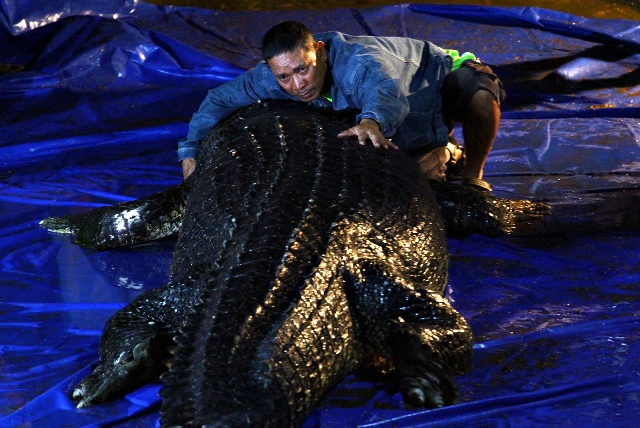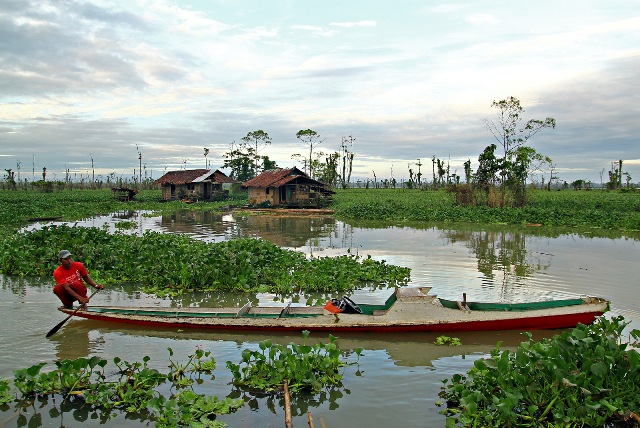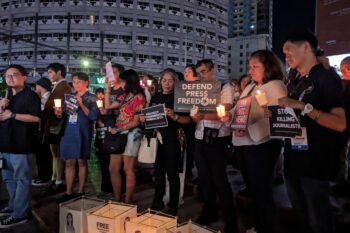LORETO, Agusan del Sur (MindaNews/14 February) – An indigenous community living in Agusan Marsh urged the protection of the remaining crocodiles and other forms of wildlife in their area a few days after the death of “Lolong”, the world’s biggest crocodile in captivity that became a tourist attraction in neighboring Bunawan town.
Roselyn Tahil, speaking for the Tribong Manobo of Sitio Panglabuhan Loreto Agusan Marsh Organization (TMOSPLAMO) stressed the crocodiles were never a threat to the community.
“For several decades our ancestors had been living here among the crocodiles and all the wildlife, we always had a peaceful coexistence with nature. We hope that people learned a valuable lesson after Lolong’s death, the government should be protecting nature and the ecosystem where they live and not raise them inside cages,” said Tahil.
 LAST HUG. Lolong receives a last hug from Eutiquiano Aguillon also known as Loloy. the crocodile’s
LAST HUG. Lolong receives a last hug from Eutiquiano Aguillon also known as Loloy. the crocodile’s
caregiver a few minutes before the start of the necropsy at around 2 a.m. Tuesday/ MindaNews photo by Erwin Mascarinas
Together with other members of the tribal organization, Tahil pointed out that what should be done instead is to protect the entire ecosystem of the marshland.
“Activities such as Illegal logging and illegal fishing with the use of electrocution devices are situations that had triggered crocodile attacks in the past. One example would be a person who was bitten by a crocodile after he placed electric current into the water to catch fish,” she said.
Ferdinand Cruz, facilitator of Samdhana Institute, a nongovernment organization that has been working closely with the indigenous community over the past two years, said: “Our group has been educating the people here to respect and stop all these illegal activities, and so far we don’t have a single incident even if the crocodiles pass near these floating houses”.
Marsh dwellers live in floating houses that rise and fall with the water level.
“The electrocution fishing that’s been happening in other parts of the marshland, for example in Bunawan, is killing not only the adult fish but also the fingerlings, and is hurting the crocodiles and of course they would fight back,” said Cruz.
He added that thousands of birds such as Purple Herons, Egrets, Philippine Sea Eagles and other species thrive on the unique ecosystem provided by the marshland.
 A boat operator paddles between water hyacinths in Sitio Panlabuhan, Loreto town in Agusan del Sur. Behind him are two floating houses in the middle of the Agusan Marsh. MindaNews photo by Erwin Mascarinas
A boat operator paddles between water hyacinths in Sitio Panlabuhan, Loreto town in Agusan del Sur. Behind him are two floating houses in the middle of the Agusan Marsh. MindaNews photo by Erwin Mascarinas
“Animals such as the crocodiles, birds, turtles, fruits bats, fishes as well as the plants and trees here are all connected and bound by nature. Taking anything or anyone of them out of the picture would spell an ecological problem in the web of life, and we human beings are part of that,” he emphasized.
Carl Ceasar Rebuta, associate executive director of the Legal Rights and Natural Resources Center Inc., urged for respect for and protection of the area’s biodiversity.
“Resources such as flora and fauna should be in the wild. Ecological important sites must be respected in their natural habitat and people should be taught in how to protect them as well as how to manage their resources,” Rebuta said.
Daisy Ballandanes, resident of barangay Nueva Era, Bunawan where Lolong was captured she wasn’t surprised that the crocodile died in captivity.
“If people can only see how different the original home of Lolong was from the cage where he was placed, then they would know why he died. In the marsh, it is cold and big compared to the hot and small cage where he was kept,” she explained.
Agusan Marsh has an area roughly the size of Metro Manila. Aside from the native species of wildlife, the marsh also hosts birds that seek refuge from the winter season in China, Japan and other countries in the north. (Erwin Mascarinas/MindaNews)
